- HOME
- Best practices
- Knowledge base
- Question types in Zoho Survey: A comprehensive guide
Question types in Zoho Survey: A comprehensive guide
- Last Updated : August 12, 2024
- 1.2K Views
- 6 Min Read
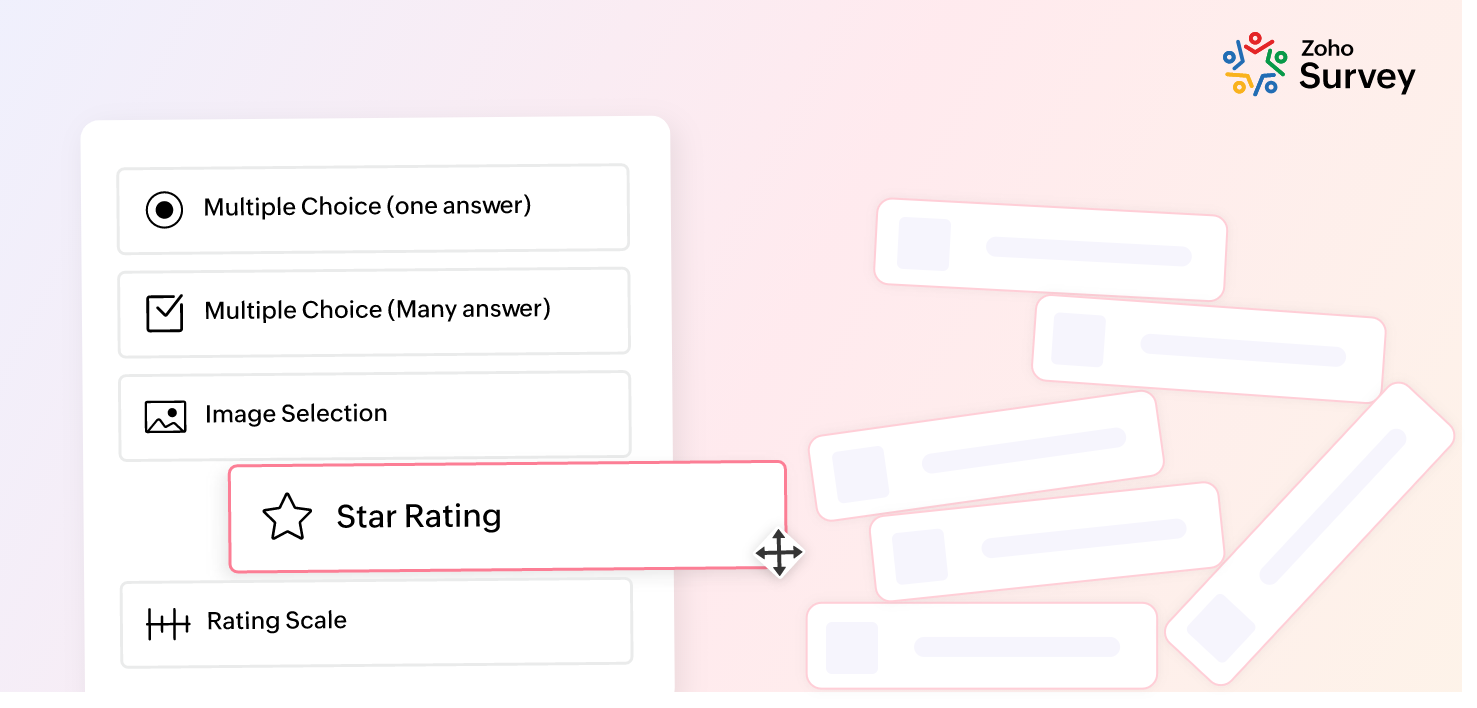
Asking the right questions is essential for gathering insights, understanding opinions, and making informed decisions. Zoho Survey, a powerful online survey tool, equips you with a diverse array of question types for comprehensive data collection. Whether you're aiming to learn about customer preferences, evaluate employee satisfaction, or analyze market trends, the question types in Zoho Survey provide you with the flexibility and precision to extract meaningful information.
Why do we have different question types?
Varied question types add an element of intrigue for participants, making surveys feel more engaging and lessmonotonous. In this article, we will explore each question format offered by Zoho Survey and share examples of how they can be used.
Which question type is best for your survey?
Selecting the right question types for a survey can help you gather meaningful insights. Let's take a brief look at the most common question types and how they can be used.
Multiple choice questions are ideal for collecting quantitative data by offering respondents predefined options to choose from. They're great for obtaining demographic information and can be particularly helpful when you want to compare responses.
Open-ended questions encourage respondents to provide detailed, qualitative insights, and can be used to gather more in-depth feedback. These questions are perfect for gaining a deeper understanding of customer experiences, opinions, or suggestions.
Likert scale questions help you gauge attitudes and opinions on a scale, so you can measure satisfaction levels.
Ranking questions allow participants to prioritize options, making these questions valuable for market research or product preference surveys. By tailoring question types to your survey's objectives, you can extract the most valuable information from your respondents.
Matrix questions are suitable for evaluating multiple aspects of a topic within a single question and are often used in customer satisfaction surveys.
Net promoter score (NPS)questions are ideal for determining customer loyalty levels and willingness to recommend a product or service.
Multiple choice questions
1. Multiple choice one answer:
The multiple choice one answer question type asks survey participants to select a single choice from an array of options. This simplifies the respondent experience and enhances the clarity of data for subsequent analysis. This question format proves especially valuable in scenarios where simplicity and precision are paramount.
2. Multiple choice many answers:
The multiple choice many answers question type helps you collect diverse data. It gives survey participants the freedom to select multiple options from a list and is particularly helpful in situations where respondents can make numerous pertinent choices. This format enriches the depth and nuance of collected insights for a more comprehensive understanding of participant preferences and perspectives.
Dropdown selections
1. Dropdown one answer:
When it comes to simplifying survey interfaces, the dropdown one answer question type shines. This format condenses response options into a tidy dropdown menu and prompts respondents to make a single selection. By incorporating the dropdown one answer format, you're enhancing user convenience without compromising data quality.
2. Dropdown many answers:
When space optimization is crucial, the dropdown many answers question type is a valuable solution. It not only streamlines the selection process but also preserves screen real estate. Respondents can readily explore and pick from various options, making this question type ideal for concise yet comprehensive interactions.
Visual selections
1. Image selection:
Elevate engagement and the aesthetic appeal of your survey with Zoho Survey's image selection feature. Empower participants to convey their preferences through the simple act of clicking on images. This approach is particularly well-suited for capturing instinctive choices, bridging the communication gap through the compelling medium of visuals.

2. Signature:
The signature question type enables survey participants to furnish their digital signatures. This intuitive feature adds an extra layer of personalization and security to the responses collected, ensuring a more reliable and trustworthy data collection process.
Rating and feedback
1. Rating scale:
Use a rating scale to measure the sentiments and satisfaction levels of your survey participants. This question format prompts respondents to rate specific statements using a pre-defined scale, enabling you to assess subjective viewpoints numerically. This approach greatly enhances the depth of your data analysis, revealing valuable insights that can inform your decisions and strategies.
2. Star rating:
The star rating question type allows respondents to efficiently rate various items with a familiar and intuitive star-based system. This mechanism seamlessly transforms intricate opinions and feedback into a user-friendly and universally comprehensible format, simplifying the process of gathering valuable insights.
3. NPS (net promoter score):
The net promoter score (NPS) question type helps you gauge customer loyalty by measuring the probability of customers recommending a product or service to others. Through these insights, businesses can build strategies for bolstering customer relationships and elevating overall satisfaction levels.
Scale and ranges
1. Slider scale:
The slider scale question empowers survey participants to express their opinions using an intuitive sliding mechanism. Its interactive nature leads to more accurate data collection, making it an essential asset for any surveyor seeking comprehensive insights.
2. Continuous sum:
Maximize your survey's efficiency with the continuous sum question type. Encourage participants to distribute a predetermined sum of points between different options. This dynamic approach to prioritization empowers you to extract comprehensive insights while increasing participant engagement.
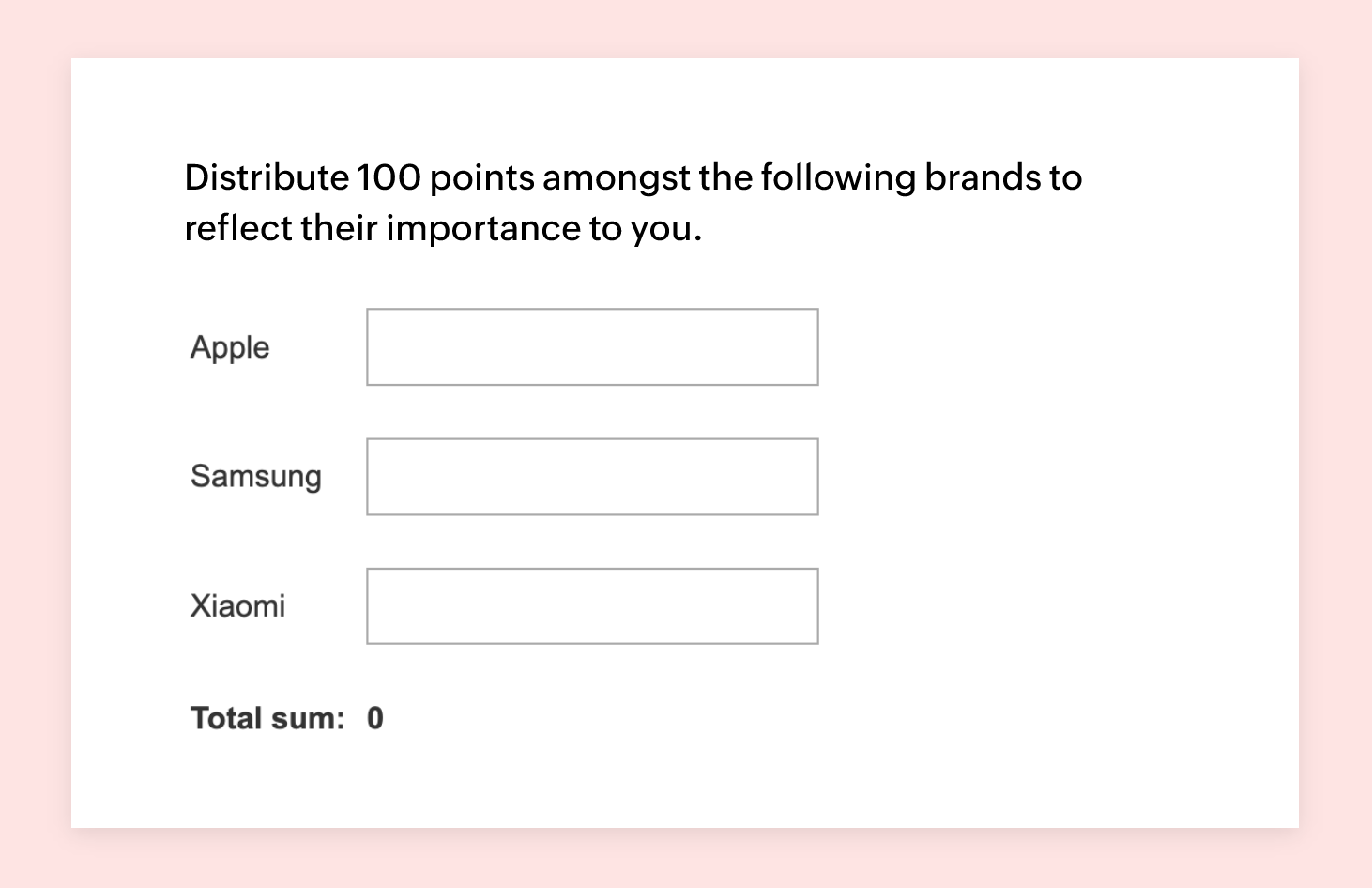
Ranking and order
This format prompts survey participants to establish a definitive order among various options. This helps you clearly understand their priorities and preferences, enriching the depth of insights gathered from their responses.

Binary options
Leverage the simplicity of the Boolean question type to effortlessly gather precise responses. This one is tailored for true/false or yes/no questions, so you can capture succinct information and streamline your data collection process.

Matrix choices
1. Matrix choice one answer:
The matrix choice one answer question type empowers participants to make a solitary selection from an array of options presented in a grid format. This functionality helps you collect well-organized feedback on diverse aspects of a topic. Whether you're looking to gauge preferences or collect opinions, this feature offers a methodical approach to gathering insights.

2. Matrix choice many answers:
The multi-choice matrix question format enables participants to select multiple choices from a grid of options. This format is ideal for scenarios where respondents can offer multiple responses , allowing for comprehensive and flexible input.
, allowing for comprehensive and flexible input.
Matrix rating and feedback
1. Matrix rating scale:
Matrix rating scale questions enable participants to assess elements of the topic with a uniform rating system. This question type ensures a standardized scale for evaluation across the board.
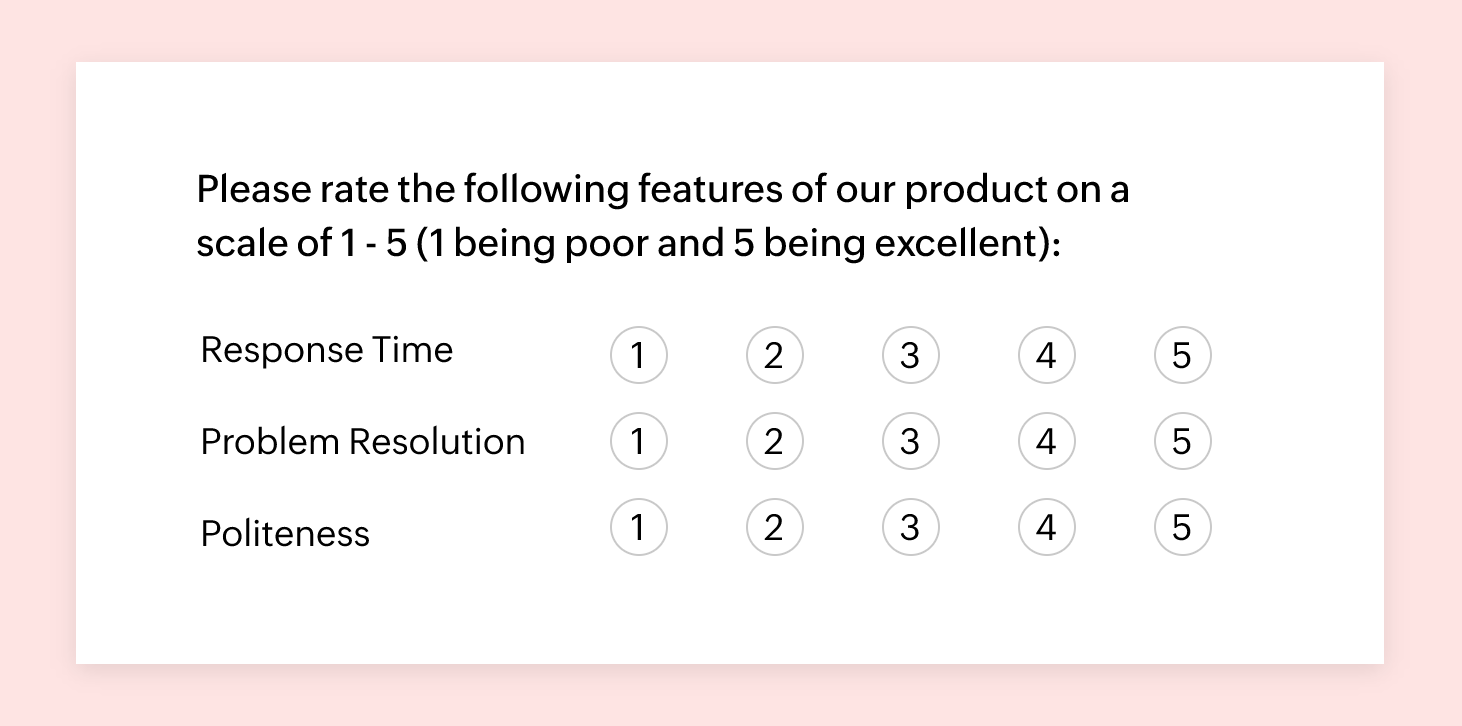
2. Matrix star rating:
This innovative question format empowers participants to allocate star ratings to a variety of items, enhancing engagement through a visually appealing interface.
Complex matrix inputs
1. Matrix Dropdown:
Matrix dropdown questions prompt respondents to make selections from dropdown menus. This approach allows them to choose options for specific intersections of rows and columns. By offering a comprehensive array of choices within a structured grid, these questions efficiently capture nuanced preferences and opinions.
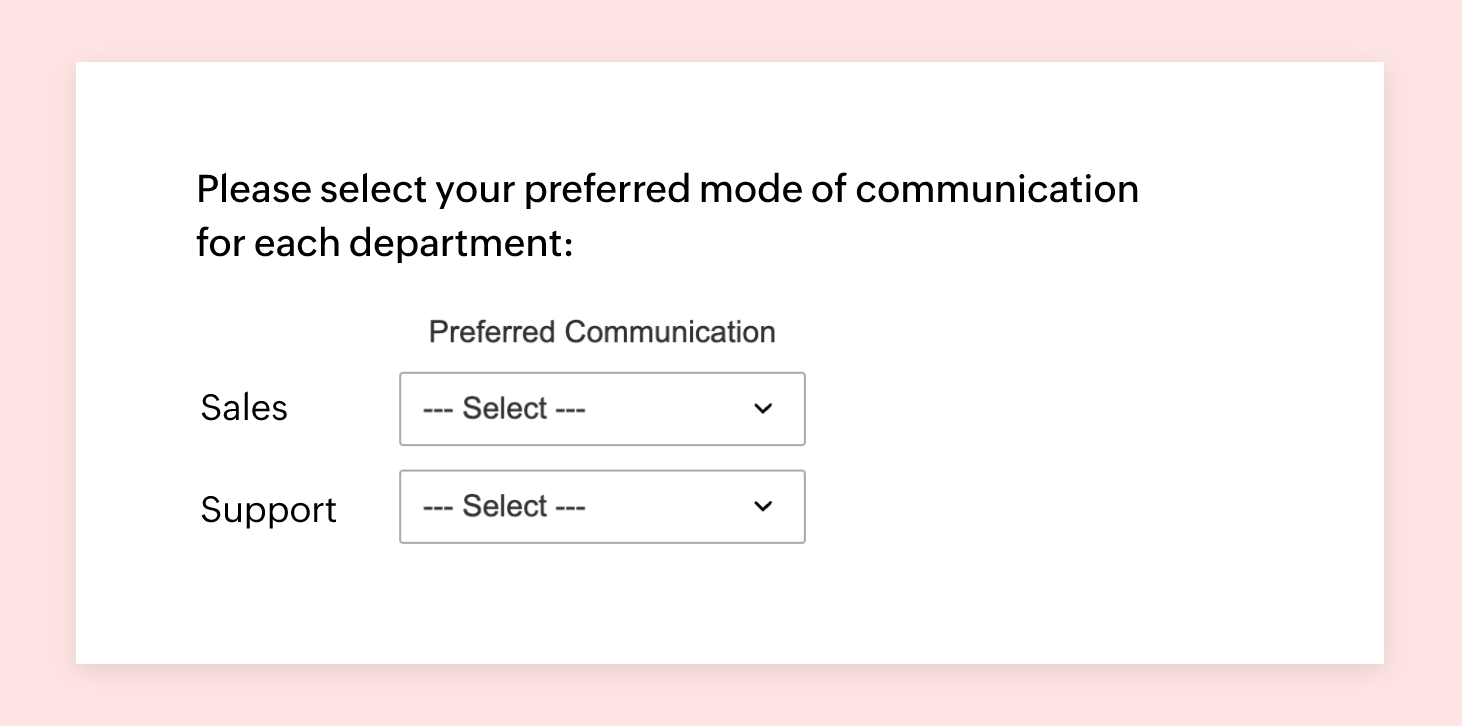
2. Matrix grid:
Matrix grid questions offer a dynamic framework for collecting comprehensive feedback, enabling participants to furnish multiple answers within an organized grid structure. This versatile format helps you capture intricate insights more efficiently.
3. Matrix textbox:
Matrix textbox questions combine a set of statements with textboxes, allowing respondents to provide detailed comments or explanations for each item. This is handy when you want to pose multiple open-ended questions.
Using these diverse matrix question types in Zoho Survey, you can efficiently collect structured and detailed feedback from your respondents, gaining insights that can inform decision-making and improvements.
Text inputs
1. Short answer:
Gain quick insights through succinct responses with the short answer question type. It's perfect for swiftly collecting concise, text-based information.
2. Long answer:
The long answer question type helps you gather detailed and comprehensive text-based responses, making it ideal for capturing in-depth feedback and explanations.
3. Number:
When numbers matter to your survey, use the number question type. Gather quantitative data, such as age or income, with ease through your surveys.
4. Email:
Enable future communication and follow-up by collecting email addresses using the email question type.
5. Date/time:
The date/time question type allows you to gather information related to specific dates or times. This can be used for scheduling, event planning, or tracking trends over time.
6. Heading/description:
Headings and descriptions are not questions per se, but they provide context and guidance for respondents, helping them understand the survey's purpose and structure.
Multiple text inputs
1. Multiple textboxes:
Multiple textboxes allow respondents to provide multiple open-ended responses within a single question. This is useful when you need to gather multiple pieces of related information.
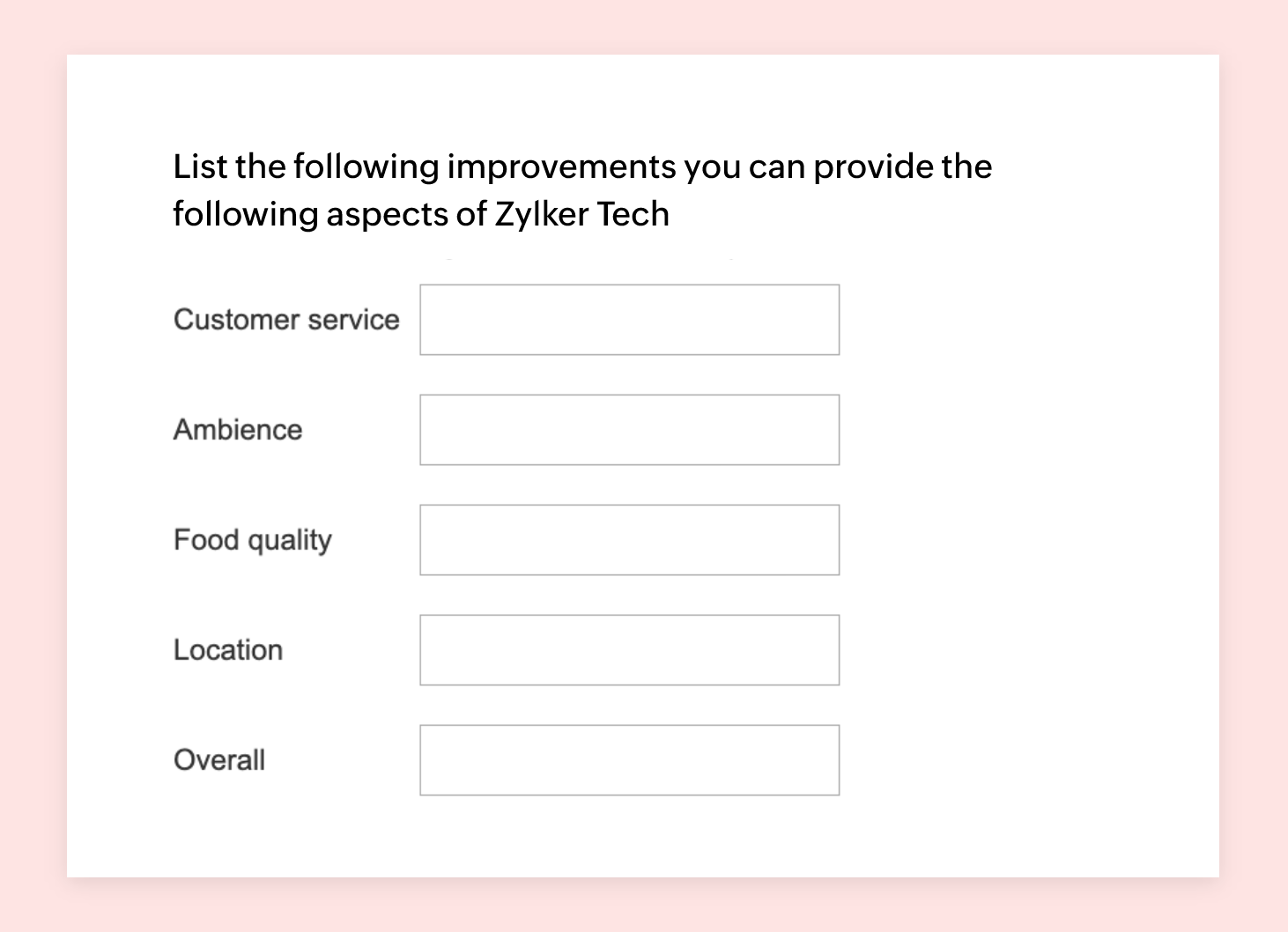
2. Full name:
The full name question type enables you to collect the complete names of your respondents, which can be essential for personalization and communication purposes.
3. Contact information:
Collecting the contact details of respondents is crucial for follow-up communication and the contact information question type helps you gather email addresses, phone numbers, and more.

File handling
Enable participants to effortlessly share different formats of documents, images, and files using the file upload question type.

These diverse question types can be seamlessly combined to create comprehensive surveys tailored to your needs. Extract meaningful insights from your respondents for more informed decision-making.
Zoho Survey's range of question types offers flexibility and customization in your approach to gathering data. By strategically incorporating these question types, you can optimize your surveys to collect relevant and actionable information from your target audience. Whether you're collecting dates, contact information, or open-ended responses, Zoho Survey can make the process smoother and more insightful.


